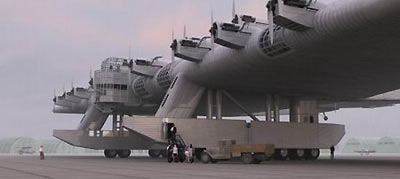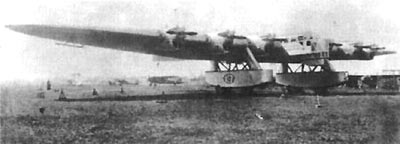Airplane-Giant K-7 now & then
In early 30's aviation design bureau, lead by K.A.Kalinin, was a well set team capable to solve absolutely new unexpected problems in aircraft design. For example, the 1929-1930 schedule KB included producing 3-engined passenger aircraft K-7, also designated as "K-Tjazholij" (K-Heavy), for the 500hp German BMW "Hornet" engines. It was designed to carry 22 passengers. Mockup prototype was tested in the TsAGI wind tunnel in September 1928, and was approved for production by the Scientific-Technical Commetee VVS in March following year.
But production was not started, and designation K-7 was used later for transcontinental aircraft project, started in 1928. 'Idea to built K-7,- K.A.Kalinin wrote later,- came to me long ago, as early as 1925. In 1929 the project was formulated and after two years of refinement it started to come to life... During creation of new huge machines new paths lead to new schemes of aircraft, to using of the wing to house payload. It means that those paths lead to the flying wing, which is exactly the perfect aircraft. To complete the transition to flying wing it is necessary to build a plane following the concept "everything is in the wing"'.
Original aircraft design was whole-wood with a 5-spar wing. But it suffered of luck of strength resource, and after long debates K.A.Kalinin decided to switch to whole-metal welded construction with 3-spar wing.
The K-7 was a gigantic elliptical wing of extremely thick airfoil (span 53m, area 452m2) with two triangle section tailbooms, carrying tailfin and tailplane with control mechanics. The wing had almost strait center (width 6m, length 10m, height 2.33m) where rooms for payload and people was arranged. Elliptical consoles with 14 fuel tanks were attached to the centroplane. The center was covered with duralumin, consoles with fabric. There were no such a thick tubes to comply with requirements of central spar so it was made of two parallel tubes. The rest of wings frame also was made of welded steel tubes.
A nacell was proturbed from the leading edge, with cockpit for two pilots, navigator, radio-navigator and chief mechanic. Seven more crew members were located in other sections of aircraft and communicated by internal telephone.
The aircraft was designed for 6 BMW engines, but later decision was made to install homemade AM-34. Six water-cooled engines lacked power, and K.A.Kalinin was forced to add 7th pusher engine on the trailing edge of the wing between tailbooms. Designer was aware that this engine will increase airflow turbulence and can lead to vibration of all aircraft, but he had no other choice. Early AM-34 engines were not equipped with gearboxes and had power only 750hp.
Triangle tailbooms were proturbed from the last spar to the tail. Tailbooms were equipped wit pneumatics, protecting the tail from undesired contact with the ground.
Original main gear design allowed aircraft to have a horizontal position while on the ground. Main gear consisted of two wide placed undercarriage of frame design with oil-pneumatic wheel suspension, the first attempt in Soviet heavy aircraft. Another innovation for this aircraft class were tires with cameras "GoodYear". Soviet industry had no such tires in production, and it had to start it in future for production aircraft.
Undercarriage had 3 wheels each and were covered with fairings - metallic 'pants' - left of which had an entry door and stair leading into the wing.
Yet on design stage it became clear that it will be hard for pilot to control the plane because enormous load on the controls. Though for the original design K.A.Kalinin proposed decision which later was widely used in aviation - electric 'boosters'. Contract was signed with one of Moscow electrotechnic institutions, which took a duty to develop and manufacture new system. But developers failed to do so, and control planes of K-7 were equipped with surfaces, placed on light booms.
Theoretical problems of heavy aircraft control by use of surfaces was solved by aerodynamic team lead by N.F.Freiman. On the TsAGI wind tunnel more than 300 successful tests were performed, and in 1932 surfaces were tested on the K-5 flying laboratory. The functionality was perfect, and it was recommended to install them on K-7.
K.A.Kalinin also decided to use chromium-molibdenium tubes for aircraft frame - it was the very first use of those tubes in our country. Calculation for the frame were lead by professor A.S.Balinsky - prominent scientist in the field of materials strength. But aircraft was overweight still in project, because calculation had to take into account loose strength of tubes near wielded joints.
Steel tube production started (at the same time with aircraft design) at the Dnepropetrovsk Metal Works. Until this similar tubes were imported from Sweden, and to buy tubes for single K-7 could cost as much as 100,000 golden rubles ($$ ? - 30's). As the TsAGI commission noted in 1932, the K-7 deserve to be a big step forward in aircraft design just because it stimulated practical use of chrome-molibdenium tubes in the USSR.
K-7 was designed as a multipurpose civil and military aircraft. One of passenger options was developed to carry 128 passengers up to 5,000km. Other design - "luxe" - supposed to arrange 16 luxirily cabins for 64 passengers. Aircraft supposed to have a comfortable club-room, snack-bar and kitchen. This was the first aircraft design allowing mechanics in-flight access to running engines.
A lot of efforts were spend on K-7 by armament team lead by D.I.Grigorov. Military version of aircraft was a real "flying fortress", which emerged 10 years before the American Boeing B-17. Defenses of Kalinin's giant reached as much as 12 gunner positions (8 20mm cannons and 8 7.62mm machine guns). Special electric cart (running on strings inside of tailbooms) was designed for "transportation" of gunners to two tail machine guns. Aircraft had no "blind spots", and every direction was under fire at least from 3 gunners, what greatly increased reliability of defence.
Bombs were located in wing bomb bays, and bomb bays frames were included into wing structure. Depending on the required range, bomb load varied from 9,900kg to 16,600kg (25,550 - 42,840lb). External fuel tanks allowed 2,400km flight with 6,000kg bombs.
Other military modification could carry 112 fully equipped paratroopers. Opportunities to carry 8,4tons tank or other parachute dropable equipment between main gears was also under study.
The technical project was completed early 1932. In the yard of the Kharkov Aviation Factory wooden mockup of aircraft central part was built in scale 1:1. The size of aircraft was too big for existing manufacturing areas, and new assembly hall was built. In November 1932 assembly of experimental aircraft started, and was completed just in nine months.
In the early August 1933 aircraft was taxied to the runway. Its test pilot was M.A.Snegirev, co-pilot - A.N.Giatsinsky. First start of all engines revealed serious vibration of different aircraft parts; those were urgently strengthened. On August 19 A.M.Snegirev made the first straight flight on 5m altitude. More troubles were revealed - elevators were vibrating with amplitude up to 1m! In few days tail of the aircraft was redesigned - it became a 'biplane' with additional stabilizing surface between tailfins. Surfaces from tailfins were deleted, and those on tailplanes were moved closer to elevators.
Day before the first flight P.I.Baranov (head of the Major Management of Aviation Industry) together with test-pilot M.M.Gromov arrived to Kharkov. At 6a.m. August 21, 1933 K-7 was 'on the start' with running engines. The weather was fair despite some light clouds. Seven crew members took their positions. And, as usual, at the last moment co-pilot's seat was occupied by Kalinin himself.
After few taxis, plane took off smoothly. As A.M.Snegirev told later, 'aircraft was very responsive. It was easy to control. Hard to believe, but you just pull the yoke - and machine responds'.
K-7 made a circle over Kharkiv, and safely landed on the factory airstrip. After pilot's report M.A.Snegirev received appreciations, and K.A.Kalinin - symbolic punishment for illegal flight on the test aircraft.
In next flights became clear, that vertical vibration is gone with new tail design, but horizontal is still there. But M.A.Snegirev, employing his rich experience of test pilot, found way to suppress it by changing of engines regime. Continuous test revealed fair flying characteristics of the plane. The last factory test flight was scheduled for November 20, and plane had to fly to Moscow. It was planned to measure maximum ground level speed. This flight (10th one) was completed successfully, but ground team made a mistake which spoiled the measurements.
Next attempt was planned for November 21. For now K-7 had over 5 hours in flight. Flight plan included approaching of the 'measuring kilometer' on altitude 1000m, then lovering aircraft to 100m and triple passing of the 'ruler' on the maximum speed.
At 2p.m. K-7 took off with 20 crew members on board. Here is story of D.A.Chebyshev, one of ground engineers participated in tests : "As scheduled, K-7 flew over us and pilot figured out that we are ready for measurements. Aircraft made a turn, accelerated and started approach. In 3-4km from us it made a sudden dive at 30-400 at full speed. The first hit into the ground knocked away landing gears. Aircraft jumped and with running engines hit the ground again. Fire started..."
What was recalled by on of five survived crew members, P.I.Semerenko : "Approaching the 'measure kilometer' Snegirev gave full throttle. Tail booms vibration came up. I counted 15-20 hits. Suddenly to the noise of running engines was added sound of breaking apart left tailboom lower tube. Displaced tube edges locked the elevators, and K-7 was not able to get out of dive. I am notifying vibration, on eye estimate dive angle... Near surface aircraft makes a left pitch. I'm waiting for the end. Controls are still dead. Smash..."
Technicians and designers suffered destruction of their creation and death of 15 crew members. K.A.Kalinin was out for two months because of heart problems. But despite this catastrophe the team did not lose self-confidence. To investigate causes of the crash few competent commetees were created, with participation of the most prominent aviation experts of the country. It was concluded that destructive vibration was caused by surfaces during some regimes of the seventh engine. But there were no 'theoretical' prove of this conclusion. Only few years later M.V.Keldysh explained this (and many other similar) crash and found a solution to fight the flatter - weight balancing of elevators. But it was too late...
After obtaining expert conclusions, revealing no mistakes in aircraft design, the head of GUAP ordered Kalinin to start urgent production of two new (passenger and military) K-7's with scheduled roll-out in the beginning of 1935. Production was assigned to new base - The Voronezh Aviation Factory.
Changed views of country aviation leadership on production of heavy aircraft did not allow the team to complete development of K-7. Both planes were 'preserved' (aka 'abandoned' - A.S.), one of them half-built. Few times Kalinin tried to prove necessity of this aircraft class, but he failed to overpower opposition to his project.
(Brexians lair)














Δεν υπάρχουν σχόλια:
Δημοσίευση σχολίου